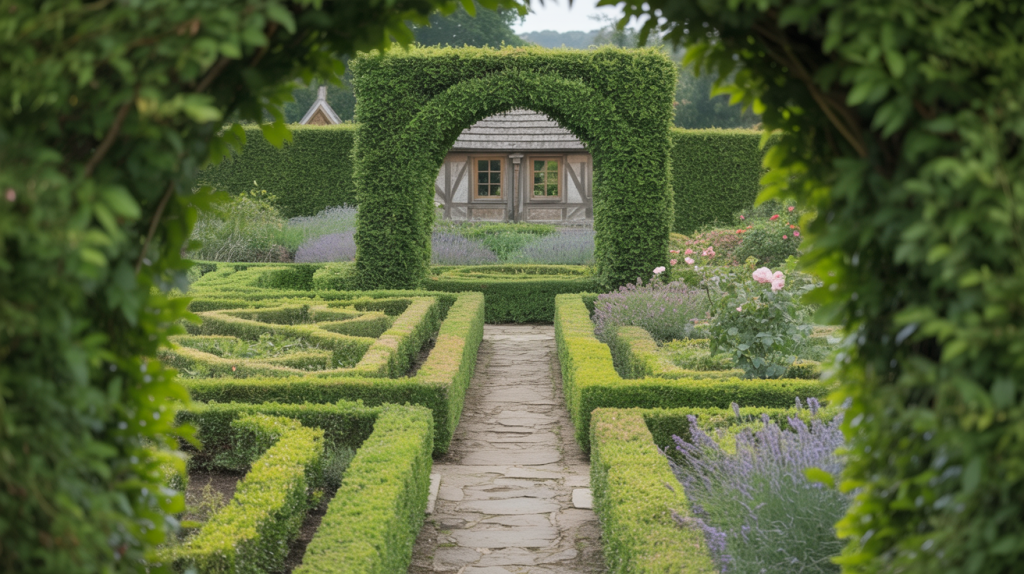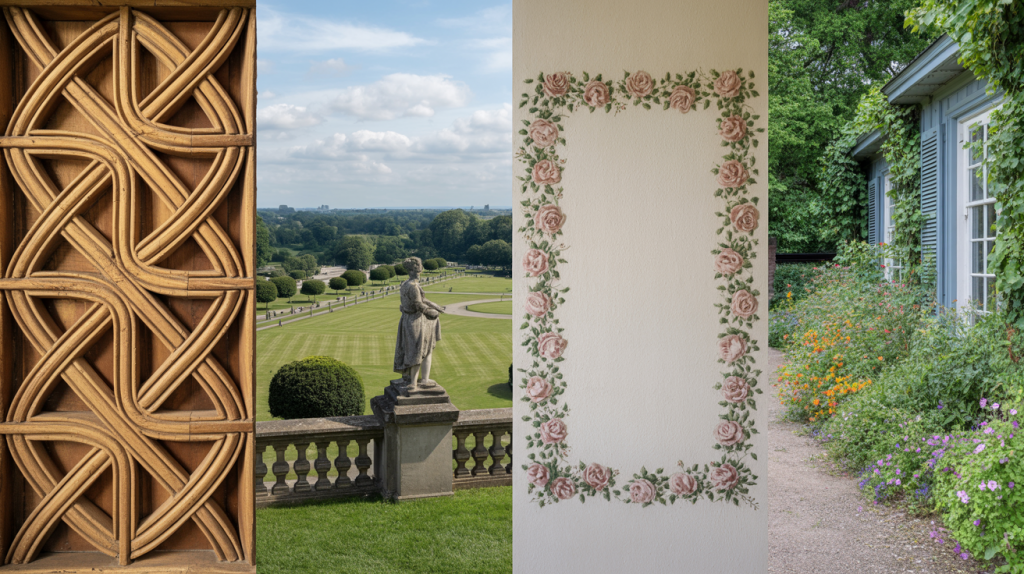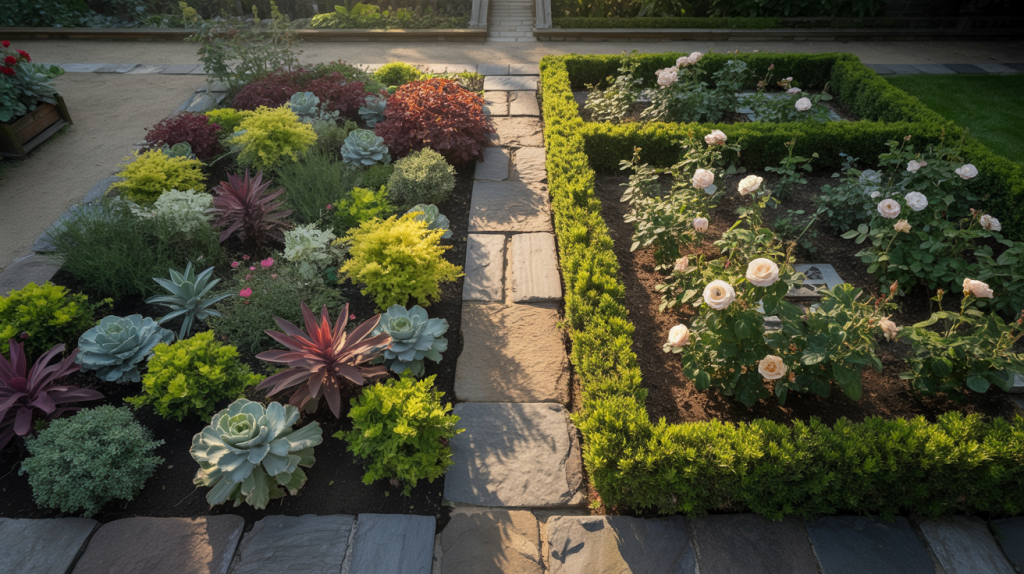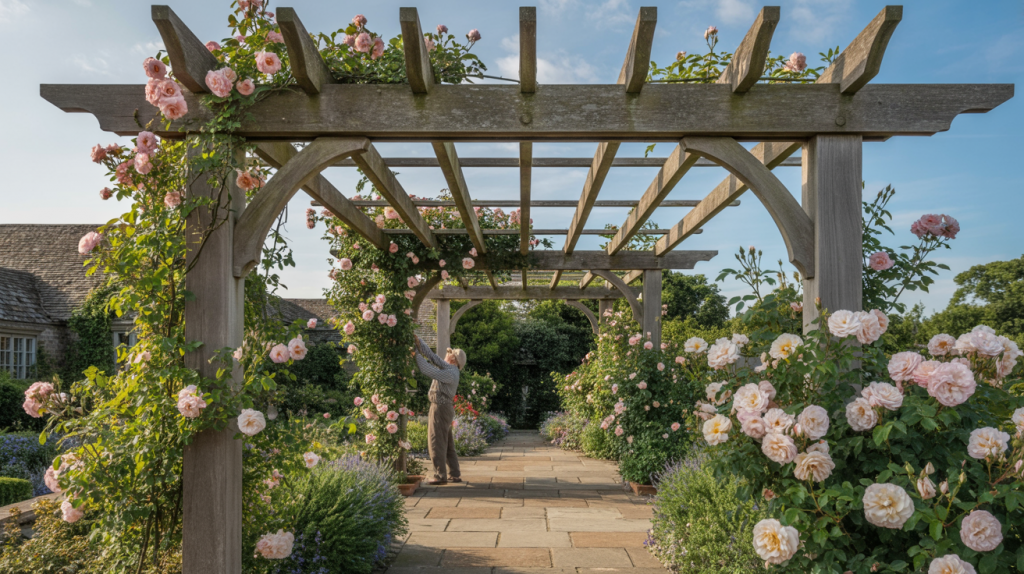We’ve lost count of the number of wonderful public gardens we’ve explored that transport you to another era. By borrowing ideas from historic British garden styles, you can create your own slice of timeless charm at home. Whether you dream of a Tudor parterre, a Victorian rose border, or a winding cottage path overflowing with herbaceous borders and climbing plants, heritage garden design weaves authenticity, sustainability and national pride into every plant and path.

In this guide we’ll stroll through everything you need to craft a heritage-inspired garden – from choosing the era that suits your aesthetic to selecting authentic plants and materials. With advice from the Royal Horticultural Society and practical tips from seasoned gardeners, your outdoor space can become more than just a garden; it can be a living piece of British history.
TL;DR
Heritage garden design is the practice of creating gardens inspired by historic British styles such as Tudor, Georgian, Victorian and traditional cottage gardens. These timeless layouts offer a tangible connection to the past while also delivering modern benefits like sustainability, lower maintenance and improved biodiversity.
Whether you’re crafting an intricate parterre or a fragrant kitchen garden, the key is to use authentic plants, materials and period-appropriate layouts. Incorporating heritage-style structures—such as timber glasshouses or oak-framed summer houses—adds both function and visual harmony when chosen to complement your garden’s era.
This guide explores the major British garden periods, provides practical planning advice, highlights common pitfalls to avoid and shares a real-life case study of heritage-garden success. By the end, you’ll have the tools and inspiration to transform your outdoor space into a historically rich British sanctuary.

What Is Heritage Garden Design?
Heritage garden design is the art of recreating historically faithful British gardens based on styles such as Tudor, Georgian, Victorian and traditional cottage plantings. Unlike much contemporary landscaping, which often celebrates minimalism and innovation, heritage gardens embrace tradition, authenticity and time-honoured beauty, lending an unmistakably classic feel to any outdoor space.
Each era has its own distinct character:
- Tudor gardens (1485–1603): Symmetrical layouts with elaborate knot designs and beds of culinary and medicinal herbs.
- Georgian gardens (1714–1830): Sweeping, pastoral landscapes with natural curves, ha-has and framed vistas.
- Victorian gardens (1837–1901): Exotic plant collections displayed in glasshouses and formal, colour-bordered flowerbeds.
- Cottage gardens: Informal abundance, overflowing with mixed perennials, herbs and edible plants.
Typical features—parterres, herbaceous borders, kitchen beds and clipped topiary—are constructed with traditional materials such as reclaimed brick, York stone and seasoned oak.
For inspiration, explore restored examples managed by the National Trust and English Heritage, where conservation teams faithfully revive planting plans and hard landscaping to reflect each period’s cultural significance.
Choosing a heritage approach is more than a stylistic preference; it creates a living link to Britain’s horticultural identity. Whether you garden in a compact courtyard or across a sprawling estate, adopting historic principles lets you cultivate a space with deep roots, layered stories and enduring soul.
Why Heritage Garden Design Matters in 2025
A renewed focus on sustainability, native planting and cultural heritage has pushed traditional garden styles back into the spotlight. Increasing numbers of British homeowners now favour heritage designs to support wildlife and celebrate national identity.
Recent research from the Royal Horticultural Society highlights biodiversity as a top priority for UK gardeners, with most respondents reporting they have made space for pollinator-friendly planting or reduced chemical use. Heritage gardens naturally meet these aims by favouring native species, layered planting and organic layouts that provide food and shelter year-round.
The appeal is more than ecological. A well-executed period garden can also enhance kerb appeal and, according to Savills research, add a meaningful premium to property values—especially for homes in conservation areas or with historic architecture.
Moreover, many heritage plant varieties are hardier and better adapted to Britain’s temperate climate than modern hybrids, reducing water and fertiliser requirements. By adopting a heritage approach you are not only restoring a piece of history but also creating a resilient, wildlife-rich landscape that embodies classic British elegance.
Step-by-Step Heritage Garden Planning Framework
Step 1: Choose Your Heritage Period
Begin by selecting the garden era that best complements your property’s architecture and your personal tastes:
- Tudor (1485–1603): Geometric knot gardens and herb beds for culinary and medicinal use.
- Georgian (1714–1830): Pastoral, landscape-style layouts with sweeping curves, ha-has and framed vistas.
- Victorian (1837–1901): Exotic plant collections in glasshouses, formal flowerbeds and ornate ironwork.
- Cottage gardens: Informal, romantic, and ideal for smaller plots—packed with mixed edibles, perennials and climbers.
Tip: Align your chosen style with your home’s façade for visual harmony.
Step 2: Assess Your Space & Conditions
Accurate site analysis sets the foundation for success:
- Measure the plot and sketch existing features.
- Conduct a soil test — see the RHS soil-testing guide for simple methods.
- Map sunlight, wind exposure and drainage patterns.
- Decide which elements to preserve, remove or screen.
- Set a phased budget, particularly for extensive planting schemes.
Step 3: Design Your Layout
Heritage gardens favour clear structure. Draft a base plan that includes:
- Period-appropriate shapes (e.g. symmetrical parterres or flowing Georgian lawns).
- Traditional paths of gravel, brick or stone.
- Defined ‘garden rooms’ such as a kitchen plot or herb knot.
- Subtle integration of modern needs—seating, children’s areas or discreet storage.
Step 4: Select Authentic Plants
Match your plant palette to the chosen era:
- Prioritise heritage varieties and native British species to support biodiversity.
- Plan for year-round interest (spring bulbs, summer roses, winter evergreens).
- Source from specialist nurseries or consult the RHS Heritage Plant Directory.
Examples
- Tudor: lavender, thyme, box.
- Victorian: ferns, old roses, pelargoniums.
- Cottage: hollyhocks, foxgloves, delphiniums.
Step 5: Choose Period Materials & Features
Materials complete the historic atmosphere:
- Paving and structures in York stone, clay brick, seasoned oak or lime mortar.
- Water elements appropriate to the era—Tudor still ponds, Georgian rills or Victorian fountains.
- Traditional garden features: arched arbours, pergolas and timber summer houses chosen to echo period detail.
- Authentic boundaries such as hedgerows, wattle fencing or low dry-stone walls.

Common Heritage Garden Mistakes & How to Fix Them
- Problem – Mixing incompatible historical periods
Fix: Select one dominant era and add only subtle influences from others. - Problem – Relying on modern hybrid plants
Fix: Consult period plant lists and source true heritage varieties. - Problem – Ignoring practical modern needs
Fix: Discreetly incorporate functional zones with complementary materials. - Problem – Over-formal layouts in small spaces
Fix: Scale down features or adopt cottage-garden principles. - Problem – Poor establishment of heritage plants
Fix: Improve soil health and choose locally adapted stock. - Problem – Inadequate maintenance planning
Fix: Schedule seasonal tasks based on traditional routines.

Expert Tips & Real-World Case Study
“Heritage gardens are living museums – they tell stories through plants, paths and proportion.”
— James Holloway, Head Gardener, National Trust
Case Study: The Victorian Walled Garden Restoration (UK)
Over a multi-year period, a team restored a Grade II-listed Victorian walled garden in England. Guided by historical research and using period-appropriate materials, they revived:
-
Thirteen Victorian glasshouses for heritage fruit and flower cultivation.
-
Seventy-two no-dig beds planted with traditional Victorian perennials and annuals.
-
Symmetrical layouts and formal beds reflecting Victorian design principles.
Results
-
The garden became a productive and beautiful space, providing food and flowers for a restaurant and local sales.
-
Visitor numbers and the garden’s profile increased, boosting the value and prestige of the property.
-
Research suggests such garden restorations can increase property value by up to 25–77%. See Post Office Money Survey summary and Sold.co.uk analysis.
-
Biodiversity, especially bee and butterfly numbers, improved thanks to diverse, nectar-rich plantings. For more, see The Royal Parks: Gardening for Biodiversity and Butterfly Conservation: Gardening for Butterflies.
Costs & Timeline
-
Costs for similar-scale private projects range from £2,750 to £9,000, depending on features and materials.
-
Major spends include plants, restoration of period structures, and hard landscaping.
Heritage Garden Design FAQ
1 · How much does a heritage garden cost to create?
Small projects can begin at about £2,000, while full redesigns may exceed £10,000, depending on size and complexity.
2 · Which heritage style works best for small British gardens?
Cottage-garden planting is ideal—informal, layered and easy to scale to compact plots.
3 · Can I grow heritage vegetables in ornamental schemes?
Yes. Many traditional layouts mix decorative and edible plants; heritage vegetables fit naturally alongside flowers in formal beds or cottage borders.
4 · How do I source authentic heritage plants and seeds?
Browse the RHS Plant Finder and specialist nurseries that focus on historical cultivars.
5 · What garden structures complement heritage styles?
Pergolas, arbours, summer houses and glasshouses in natural timber or wrought-iron finishes suit most periods.
6 · How do heritage gardens cope with British weather?
Exceptionally well, especially when you choose native species and hardy heritage varieties adapted to local conditions.
7 · Can heritage design boost property value?
Often, yes—professional execution that aligns with the home’s character can add measurable kerb appeal.
Conclusion
A heritage garden is more than a nod to the past: it’s a commitment to authenticity, sustainability and cultural continuity. Whether you begin with a single knot garden or renovate your entire plot, each step draws you closer to an outdoor space that reflects genuine British character.
You needn’t be a historian or own acres of land—even a few well-chosen heritage roses and a weathered oak bench can refresh a small space. Start modestly, plan with care and draw inspiration from centuries of British horticultural artistry and craft.
Author Bio
Katie Middleton is a UK designer who blends heritage-inspired interiors with thoughtfully planned garden spaces. She shares practical, period-savvy ideas—from whimsical children’s playhouses to oak-framed summer houses—using native planting, reclaimed materials and sustainable techniques to create cohesive “inside-out” sanctuaries.
References
- National Trust.(2024) Historic gardens: collection and conservation practices. https://www.nationaltrust.org.uk/discover/history/gardens-landscapes/plant-collectors-and-historic-gardens
- Royal Horticultural Society. (2024). Heritage plant varieties database. https://www.rhs.org.uk/plants
- English Heritage. (2024). Traditional garden design principles. https://www.english-heritage.org.uk/visit/places/gardens
- Batey, M. (2016). The Historic Gardens of England. Oxford University Press.
- Horticultural Market Research Ltd. (2024). Garden Trends Survey UK: British gardening insights 2024–2025.
Images via Ideogram

